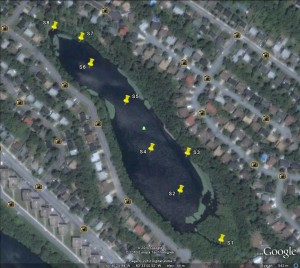Habitat Monitoring
Compiled Water Quality Data
This is an excel workbook with a data table of compiled sampling events and some graphs of various water quality measurements and analytical data. This includes information from the Synpotic Water Surveys 1980, 1991, and 2000, the HRM water quality monitoring events (2006-to present) and the Oathill Lake Conservation Society sampling events (2010).
Download the compiled water quality data:
Oathill Lake Compiled Profile Data
This data includes water quality measures at approximately 1(one) meter depth intevals taken at selected sampling stations along the lake. The measurements include pH, Temperature, Conductivity, Dissolved Oxygen, Total Dissolved Solids, and Salinity. The Oathill Lake Conservation Society intends to build a data base of measurements to evaluate the lakes health in terms of freshwater aquatic habitat(fish, frogs, and macroinvertebrate) and for human health.
Oathill Lake Compiled Profile Data Oct 2010
Waste Management
Arranged for four extra waste receptacles strategically placed around the lake in an effort to reduce both littering and pollution.
Responsible Fisheries Management
Carried out extensive reviews of the scientific and management literature as they related to the ecological health of the lake and the impacts that various factors may have on it (e.g. overstocking with top-predators – rainbow trout).
Watershed
Maps and information coming soon
Stormwater Catchment Area – Click for image (red line on drawing indicates stormwater catchment area)
Community Education
Remember almost everything that makes it to the catch basins (the grates you see on the sides of the road along the curb) in this area goes into the lake eventually; dog waste, soap from washing our cars, silt and sediment that gets washed off the street during construction projects, fertilizers and pesticides that we use. All these things contribute to a declination in the health of the lake.
What we can all do:
- Pick up after our pets, even the stuff on our own property;
- Use phosphate-free soaps for washing the car or the house/deck; better yet use commercial car washes instead of washing your car in the driveway. Car washes are equipped to handle dirt, soaps and contaminants. Run off from your driveway can wash into the storm sewer and contaminate lakes and rivers. Even biodegradable soaps can be harmful to aquatic life;
- Limit or do not use lawn\garden fertilizers, try alternatives such as compost;
- Use sediment and erosion control measures when doing projects that require excavation on our properties;
- Report any illegal dumping and sediment flow into stormwater catchbasins;
- And note below:
| Storm drains are for rain and snow melt only. Any dumping of toxic chemicals or process water, such as paints, oil, antifreeze and even soapy water into the storm drain is illegal, as provided by Halifax Water’s Schedule of Rules and Regulations for Stormwater Service. |
| If you witness someone pouring something down the storm drain, please contact the Pollution immediately. |
| Pollution Prevention staff within Halifax Water’s Environmental Services investigate and respond to incidents where pollution may enter into or leave Halifax Water’s sewer system. You can report pollution by calling the Pollution Prevention office at (902) 490-4000. |
Please keep posted for the Yellow Fish Road public education program planned for Spring 2011.
Trails
New content coming soon.

